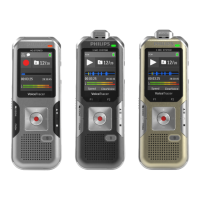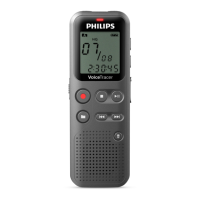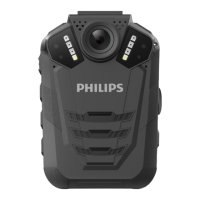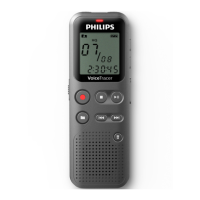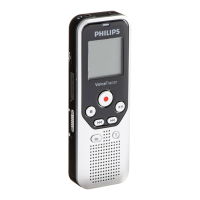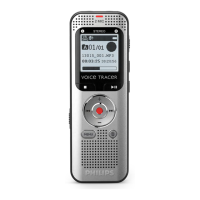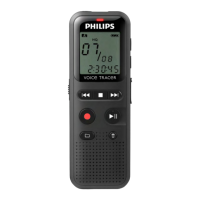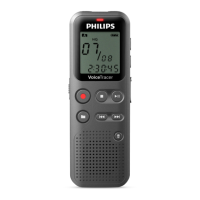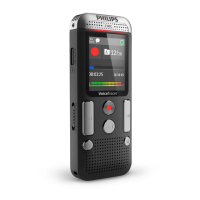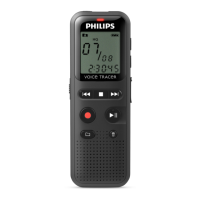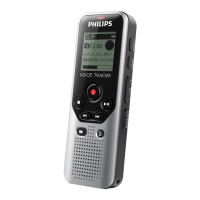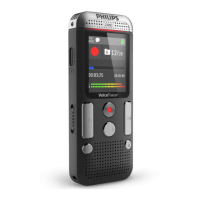
Do you have a question about the Philips DVT6000 and is the answer not in the manual?
| Display | LCD |
|---|---|
| Recording Format | MP3 |
| Microphone | Stereo |
| Battery Life | Up to 50 hours |
| Connectivity | USB 2.0 |
| Playback Features | Variable speed playback |
| Storage Capacity | 8 GB internal memory |
| Weight | 85 g |
Essential safety guidelines for device protection and proper usage, including handling, environment, and maintenance.
Information on charging, using, and disposing of batteries and rechargeable batteries for the device and remote control.
Details on supported microSD card capacity, data transfer rates, and formatting procedures.
Guidelines for safe headphone usage to prevent hearing damage and ensure situational awareness.
Information on the manufacturer's compliance with sound power regulations for supplied headphones.
Awareness of legal restrictions and privacy rights when using the device's recording functions.
Overview of device features and diagrams applicable to specific models in the product range.
Explanation of symbols used in the manual to aid understanding of device operations.
Key features and benefits of the Philips Voice Tracer recorder, including sound quality and design.
List of items included in the product package for different Voice Tracer models.
Detailed description and diagrams of the recorder's front and rear sides, including all buttons and ports.
Explanation of the device's start-up screen and the meaning of its various icons and indicators.
Instructions for charging the device's battery using a computer or external charger.
Procedure for turning the device on and off using the power switch.
Steps for initial setup, including selecting language and setting date and time.
How to access and view recording properties and general device information on the display.
Instructions for locking and unlocking the device's keypad to prevent accidental operation.
Guide on how to properly insert a microSD card for expanded storage.
Instructions for extending the fold-out stand on the rear of specific models for stable placement.
Guide on how to use the remote control, including initial setup and operating range.
Information on available accessories and how to connect headphones and external microphones.
Steps for connecting the device to a computer for data transfer and power supply.
How to configure recording quality, microphone sensitivity, and other settings before starting a recording.
Procedure for connecting and using an external microphone as the recording source.
How to add index marks during recording to mark important points for reference.
Using the zoom function to focus the microphone on a distant sound source.
Enabling the pre-recording feature to capture up to five seconds before pressing the record button.
Options for starting recordings automatically using a timer or voice activation.
How to select a recording or music file for playback using folder selection and navigation.
Searching for recordings by date using the calendar search function.
Instructions for playing back recordings and music files, including volume and pause controls.
How to change the playback speed to slow, normal, or fast.
Scanning backward or forward within a file at a fast speed to locate specific parts.
Setting up repeat playback for files, folders, or sequences (looping).
How to edit existing recordings by adding new parts or overwriting sections.
Detailed steps for adding new audio or overwriting existing parts of a recording.
How to split a large recording into two separate files for easier management.
Instructions for deleting individual recordings or entire folders from the device's memory.
How to enter and exit radio mode, tune into stations, and adjust volume.
Methods for saving radio stations, including automatic and manual search and storage.
Automated process for scanning and saving available radio stations.
Manual process for tuning to a specific frequency and saving it as a preset.
How to remove a saved radio station from the presets.
Choosing between headphones or speakers for radio playback.
Instructions on how to record audio directly from the FM radio.
Configuration options for recording quality, file location, sensitivity, and audio enhancements.
Selecting whether recordings are saved to internal memory or a microSD card.
Enabling automatic adjustment of recording settings based on detected environment (Meeting/Conversation).
Choosing the file format and bit rate for recording, affecting file size and quality.
Adjusting microphone sensitivity levels and selecting optimized settings for different recording scenarios.
Activating the wind filter to reduce wind noise during outdoor recordings.
Using noise reduction to minimize background noise in challenging recording environments.
Configuring the device for editing, such as adding new parts or overwriting existing recordings.
Disabling visual and audio indicators during recording for discreet operation.
Enabling the pre-recording feature to capture audio before the record button is pressed.
Setting a specific date and time for the device to start recording automatically.
Activating voice-activated recording that starts and pauses based on speech detection.
Automatically splitting recordings into segments at set time intervals.
Controlling the status LED indicator that shows when the device is recording.
Configuring the device to use external microphones or line-in sources.
Options for customizing the display, including language, contrast, and backlight.
Choosing the display language for the device interface.
Adjusting the screen contrast for better readability.
Setting the display backlight duration or auto-adjust mode.
Enabling demonstration mode to display sample images on the screen.
Configuration for device-specific settings like date, time, ClearVoice, equalizer, and auto-off.
Setting the current date and time for accurate recording timestamps.
Activating ClearVoice for improved speech intelligibility during playback.
Customizing audio frequency settings for music playback to enhance listening experience.
Configuring the automatic power-off feature to save battery life.
Using the device as an alarm clock or appointment reminder with custom sounds.
Controlling the audible feedback for button presses and system alerts.
Accessing service-related functions like displaying device information and formatting memory.
Viewing general device information, including firmware version and storage status.
Formatting internal memory or microSD card to delete all data and prepare for reuse.
Step-by-step guide for replacing the battery in the remote control.
Instructions for updating the device's firmware to the latest version for bug fixes and improvements.
Common problems and their solutions for issues like device not turning on, no playback, or no sound.
Detailed technical specifications of the device, including dimensions, weight, recording formats, and battery life.
